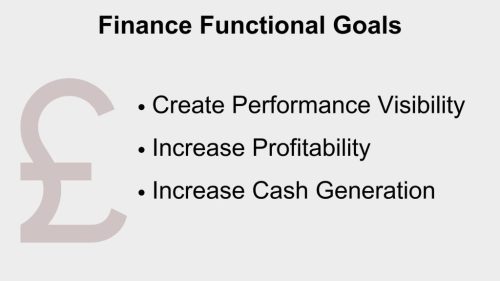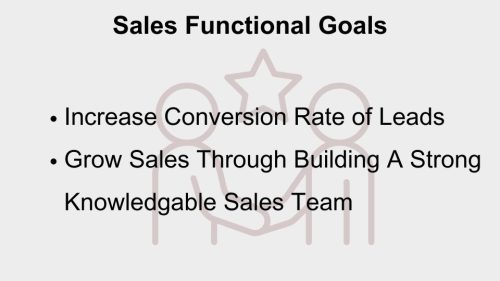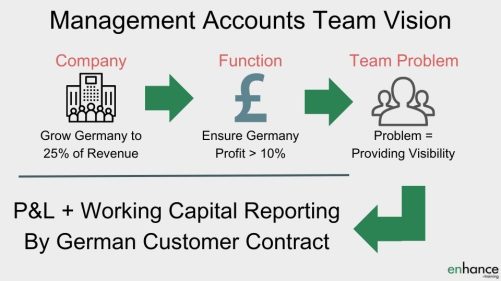7 Ways to Create a Team Vision – Linking Company Strategy to Your Team

Create a team vision that your team understands and relates to, and you give them better direction and motivation. Explaining the purpose of your team and how their work creates value for the company as whole is very motivational for most people.
When you link your team vision into the functional goals and the company’s strategy, you are helping your team understand the context of their work, how they fit into the bigger picture and what they can do to be individually successful and contribute to the company’s and team’s success.
We all feel happier and more fulfilled when we can directly see how our work creates value for the wider team. Knowing how our work fits into the company strategy provides safety and knowledge that our bosses will be happy.
Create a team vision to link what each person does day to day to the bigger picture and your team will be happier, more motivated, and ultimately more successful.
7 Ways to Create a Team Vision
- Understand the Company Strategy
- What problems are you really solving
- Creating a relatable vision
- Set clear and measurable goals
- Break down the goals into team inputs
- Assigning ownership of individual goals
- Outline milestones and progress measurement
The last few steps are sharing tips on how to implement your vision or turn it from a good idea into reality for you and your team which is usually the hardest part.
Watch on YouTube
Listen on Podcast
The first way to create a team vision is to understand the Company Strategy
Linking company strategy to team objectives is a great way to keep your bosses happy and your team’s efforts co-ordinated with everyone else’s efforts. Studies estimate that more than 70% of companies fail to implement their strategies and achieve the success they should.
How to create your team vision is easier when you start with looking at the function you work in.
What underlying purpose does your function undertake within the business and what are the functional goals? Understand this before you think about explaining the purpose of your team.
- For instance, finance’s purpose might be to create performance visibility and increasing profitability and cash generation of the company.
- Marketing might be to build a recognised and trusted brand and increase the number of leads fed to the sales team.
- Sales might be to increase the conversion rate of the leads generated and grow sales by recruiting and training a strong knowledgeable sales team.
Understand what your function’s role and purpose is in relation to the company strategy before you think about how to create a team vision.
Depending on the size of your team, your team might be the function or it might be part of the function. The smaller your team in relation to the business, the smaller part of the company strategy your team’s work will feed into as a general rule.
Your team vision should be relevant to your team for several years, rather than just be a different way of stating the team’s objectives for the year.
Communicating strategy to your team should be focused on what role they specifically play in implementing the company strategy.

work out what problems are you really solving – step two when linking company strategy to your team,
Many managers make the mistake of regurgitating the parts of the company strategy they think are relevant to their team. This doesn’t make the strategy relatable to individual team members. To motivate your team members, your team vision needs to be phrased in language and problems that your team can directly relate to.
So work out what problems your team are solving that feed into the functional goals and company strategy.
Sticking with the finance example touched on earlier – part of the company strategy might be expanding Germany to be more than 25% of the group’s revenue. The finance function might be tasked with ensuring profitability in Germany is more than 10%.
The problem your management accounts team might face is creating visibility to support both these goals. A solution might be creating P&L and working capital reporting by German customer contract so the whole business has objective information about how each customer is supporting the company’s strategic goal in Germany.
Work out exactly what the key set of problems your team is trying to solve to support the functional goals and company strategy.

Creating a relatable vision – The third step to communicating company strategy
What is going to be the main purpose or goal of your team over the next few years? How would you use everyday language to describe the high level solution to the big problems facing the team?
Answer these two questions clearly and you will have a good relatable vision to share with your team.
Keep your team vision simple and straightforward. A team vision doesn’t have to be and probably shouldn’t be a masterpiece of wordsmithing.
Back to the financial example used earlier, your team vision could be:
“To create and share detailed financial reporting at customer contract level across the business to improve decision making, accountability and profitability”
A really useful step is to put a draft team vision statement to your team and ask them to finalise it with you. This action gets the team members owning part of this step and introducing language they understand and use into the team vision statement.
Then communicate the team vision with all team members and keep reminding them of it.

The fourth step to create a team vision is set clear and measurable goals
Most of us like structure and direction at work. Setting out clear and measurable team goals is a great way to provide this to your team.
I like using the SMART framework for this step and asking the team to be involved in creating each goal. This group exercise gets everyone involved and owning the goals we create together.
Do spend enough time to get SMART goals. This is not usually a quick process. If you take an hour to get each goal really clear, that might be perfectly okay.
Do think about how you are going to measure progress. Make the measurement process is as simple as possible and ensure the data needed is easy and quick to gather.
Keep your final team goals visible and keep reminding the team of progress against the goals.
The fifth step to create a team vision is to Break down the goals into team inputs
This fifth step is helping the team move from the what – to the how – to achieve the goals. Helping the team to mentally overcome the how step massively improves the chances of reaching your goals. When we have goals but don’t really understand how we are going to reach the goal, we remain stuck and inactive. When we understand what tasks, activities, and projects we need to do to help us achieve team goals, we are much more confident of taking the right action.
Back to our finance example, some of the inputs or tasks to achieving our financial reporting vision might be:
- Set up project codes within the finance system
- Implement a simple timesheet system to capture each employee hours spent on each customer contract
- Add a project code to all invoices inputted into the finance system
- Create P&L reporting for each project code or customer contract
When you have worked out the main team inputs or activities to achieve the goals, then work out which individual will do what.
Assign ownership of individual goals – The sixth step in implementing a team vision
Once you have shared a clear team vision with the team and the goals and activities at team level, the next step is to create goals and activities at an individual level.
Focus on HOW to achieve the goals as much as the goals themselves. Work out who is best placed to work to achieve each team goal. This may be one person or several people. In each case, give overall responsibility to achieve the goal to one person to make ownership clear, even if several people will work on it.
Give each team member as much of a roadmap as you can to help them successfully achieve each of the individual goals. It is in everyone’s interests for each team member to be successful.
Running a set of team planning workshops focused on how to achieve each goal and who should be responsible can be more productive than you deciding and telling each person. If the team has a strong say, they will be more motivated and successful because it is their plan too. Teams often produce better solutions that one individual working on their own.

Outline milestones and progress measurement – The seventh step to implementing a team vision
Create visibility of progress so that everyone knows and understands exactly how far the team has progressed in reaching each goal. Visibility is a key step in driving ownership and accountability.
I would suggest you add in sensible milestones for each of your goals. The longer the time period in question, the more milestones you should add in. This is good project management, plus it gives everyone a more immediate sense of purpose and achievement. Goals to be achieve in 12 months don’t seem as real as ones that need to be achieved in the month.
Creating lots of little goals on a journey will make achieving the final end goal a lot easier.
In Summary
Create a vision of how your team will support the wider business goals. Make sure your team understands and believes in the team vision and they will be more motivated and more focused on maintaining team direction. Higher motivation levels and more focus generally means better results.
Getting the team interested and behind where you want to take the team also helps team happiness and provides a lot of satisfaction as a leader.
To recap, the 7 ways to create a team vision while linking company strategy to your team are:
- Company Strategy – understanding your team’s contribution
- What problems are you really solving
- Creating a relatable vision
- Set clear and measurable goals
- Break down the goals into team inputs
- Assigning ownership of individual goals
- Outline milestones and progress measurement
I have always felt that creating and sharing a team vision, linked to the wider business goals is a great way of providing clear direction to the team. A clear direction that everyone understands and can link to their individual jobs provides motivation and reduces confusion.
I have always preferred it when my bosses gave me a focus rather than staying silent and leaving everyone to guess what they want from each team member.
Create your own team vision for your team.





